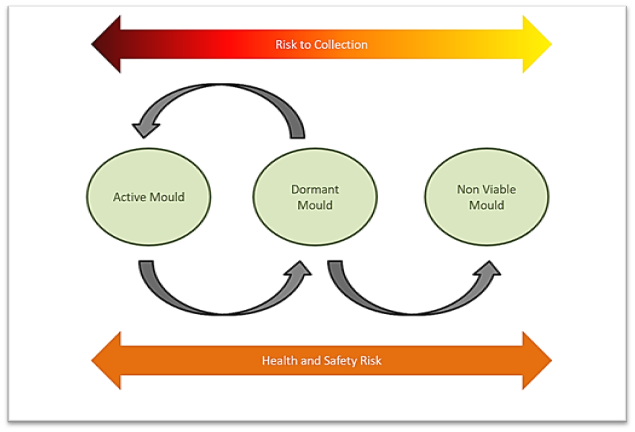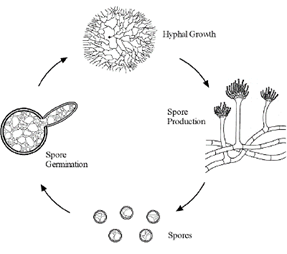Mould exists in one of three states – it is actively growing, dormant, or non-viable (dead). While it is understood that active mould is hazardous to both the collection and those accessing it, it is also important to be aware that dormant and non-viable mould also present a risk to health (Fig. 1). The effects of exposure to mould are cumulative and around 2% of the population may develop an adverse reaction to it.

Mould lifecycle stages and risk, The National Archives
When growing and reproducing, mould requires an organic food source, like paper, parchment, adhesive and other materials found in archival collections. It also needs moisture and thrives when the surrounding environment has a sustained relative humidity (RH) of +65%. When such conditions occur, germination and growth begin. Microscopic spores – or conidia – are released into the air and as they land on a surface that can support growth, they germinate into hyphae. These thread-like cells release digestive enzymes which degrade and subsequently absorb nutrients from the food source and form the visible body of the fungus, known as a mycelium.

If disturbed by air movement or by physical contact, conidia are released into the surrounding area and, given the right environmental conditions, will go on to form further mould colonies.
When active mould growth is present, you may observe:
- A perceptible musty odour, both within a storage space and on a document itself
- A damp feel to the document surface
- Noticeable changes to the appearance and condition of the document
- Fluffy or slimy growths, which may smear when touched
Identifying and responding to an active mould infestation is essential. When left untreated, active mould can spread quickly, posing a risk to the ongoing condition of your wider collection, as well as to those who access it.
As humidity levels decrease, active mould becomes dormant and it:
- Desiccates, becoming dry, powdery, or crusty and – like active mould – can be disturbed by movement
- Can remain inactive for many years but may reactivate once humidity levels create a suitable environment
- Can appear as mottling or staining on the document surface, often with dry, powdery deposits in the box – though appearance can vary widely
Because you cannot visually assess the difference between dormant and non-viable mould, (Personal Protective Equipment (PPE) should always be worn whilst handling affected collection material.
